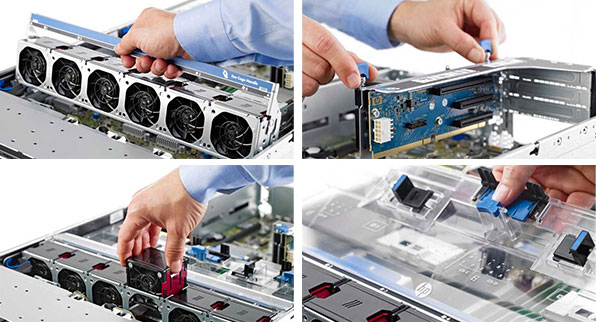It is not every day that a prominent IT company claims it will revolutionise the IT industry, and then proceeds to show you, in detail, how. That however, is exactly what HP did in Las Vegas at the launch of its Proliant Gen8 servers. TechSmart was in Vegas to get the scoop.
Dave Donatelli, HP's EVP and general manager enterprise servers, began by pointing out that while consumer technology had grown in leaps and bounds, many businesses were frustrated by the fact that their IT budget appeared to be spent on "just keeping what they have running," instead of being directed towards implementing innovative technology.
This though is set to change, thanks to the Project Voyager initiative, which has been two years in the making and cost a staggering $300 million. It includes the launch of the company's ProLiant Gen8 servers, and introduces a broad array of innovations, that apparently produced 900 patents.
Put simply, Project Voyager's aim is to automate every aspect of a server's life cycle, and effectively enable servers to become self-sufficient and "intelligently take care of themselves", explained Donatelli.
Advances and Benefits
To this end, HP's ProLiant Gen8 servers features the company's 3-D Sea of Sensors, a technology that identifies over-utilised servers based on real-time location, power, workload and temperature data. This enables users to increase their data centre's computing capacity per watt of energy by 70%. And with HP Active Health and HP Insight Online respectively, HP ProLiant Gen8 automatically analyses its own health across 1600 data points.
Despite the fact that data centres are extremely expensive, content is only expected to grow. Mark Potter, HP's senior vice president and general manager Industry standard Servers and Software, elaborated that two years ago, HP recognised that the way data centres were managed was "simply unsustainable".
This spurred the company on to make a breakthrough in data centre management. "We have fundamentally changed how a server behaves, from automatically communicating which rack it is in, validating power feeds to offering a 3D visualisation of the entire data centre so that customers can see where power and cooling is available," he elaborated.
Gen8: the power of saving
Potter continued that the net result of deploying the new ProLiant Gen8 servers is a conservative estimate of five months return on investment, while doubling a data centre's capacity. The list of savings offered by the new servers is impressive and extensive. In a nutshell, the following are some of the main savings and benefits that HP asserted will be afforded to ProLiant Gen8 users:
- Nearly double compute-per-watt capacity and potential financial saving of $7 million (R56 million) in energy costs in a typical data centre over three years.
- Seamless support and security via Insight Online, enabling customers to manage and monitor their data centre using a cloud based portal from wherever they are.
- Reduction of time spent on manual operations, such as server updates, from five hours down to ten minutes, freeing up administrator's time for better productivity.
- Resolution of unplanned downtime issues up to 66% faster, affording an incalculable benefit considering the potential $10 million per hour cost of unplanned downtime.
- Saving in excess of 30 days of administration time a year per person in a typical 10 000 square-foot data center, due to the acceleration of application deployment and automation of manual tasks.
To the point
While advances in servers and storage may usually be one of those developments that happens in the background and is given little attention to by technology enthusiasts, it is nonetheless the backbone of many businesses that users benefit from. Moreover, the ramifications of the announcement - what it can mean to businesses of every size, to the industry as a whole, and to users who rely on and benefit from data centres and servers, left us with the distinct impression that we were witnessing yet another watershed moment for the technology industry.

Patently innovative
Amongst the hundreds of patents that have emerged from Project Voyager, one particularly interesting one addresses an all too common problem of human error. The company's SmartSocket technology addresses a common problem, in which technicians bend the pins on motherboards when inserting a processor.
Instead of placing a processor onto the motherboard and potentially damaging them, SmartSocket allows users to slide the processor into a separate tray, which then precisely aligns itself to the motherboard pins. Another technology, known as SmartDrive, addresses the problem of customers removing the wrong drive, resulting in data loss, by showing via LED light warnings which drives must not be removed.